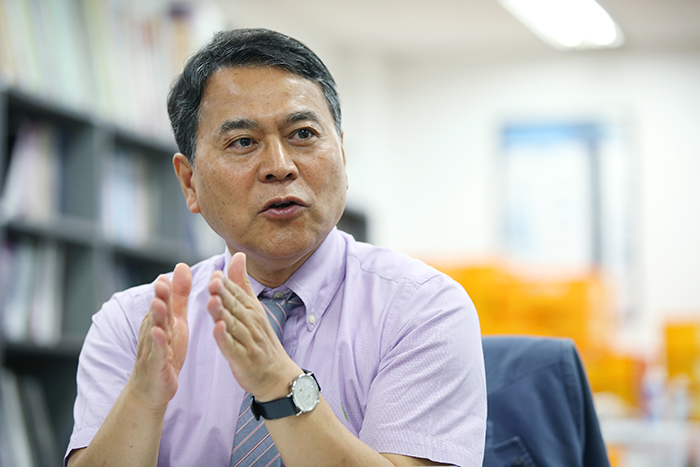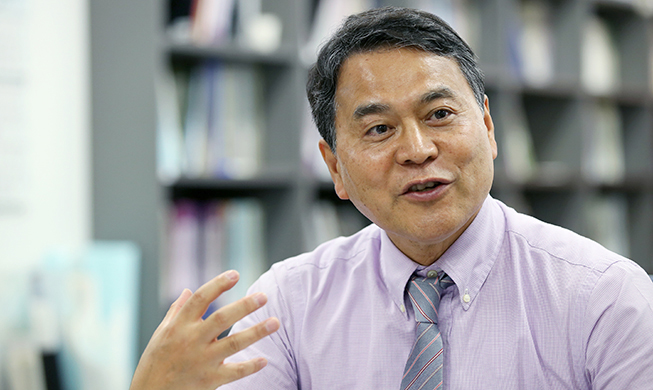
Professor Lee Hee Soo from Hanyang University's Department of Cultural Anthropology talks about exchanges between ancient Korea nations and the Islamic world. Korea.net met with him at the Hanyang University Museum in Seoul on Sept. 25. (Kim Sunjoo)
Korea and the Islamic world have had exchanges ever since the Three Kingdoms of Korea (58 B.C.-A.D. 668) that included Silla (57 B.C.-A.D. 935), Baekje (18 B.C.-A.D. 660) and Goguryeo (37 B.C.-A.D. 668).
Professor Lee Hee Soo at Hanyang University's Department of Cultural Anthropology has been researching exchanges between ancient Korean nations and the Islamic world for 37 years. Korea.net sat down with him to learn more about the history of these exchanges, as seen through ancient records from Korea and from Muslim countries. This is the second part of the interview.
Professor Lee Hee Soo at Hanyang University's Department of Cultural Anthropology has been researching exchanges between ancient Korean nations and the Islamic world for 37 years. Korea.net sat down with him to learn more about the history of these exchanges, as seen through ancient records from Korea and from Muslim countries. This is the second part of the interview.
By Kim Young Deok and Yoon Sojung
Seoul l Sept. 25, 2017
“A total of 23 books written by 18 Arab scholars described Silla as a utopia in the East,” said Professor Lee Hee Soo from Hanyang University's Department of Cultural Anthropology.
Professor Lee was explaining to Korea.net the common features he discovered in ancient Arabic documents. Lee has been studying the ways in which ancient Korea was depicted in ancient documents written in Arabic, Turkish and Persian.
In an interview at the Hanyang University Museum on Sept. 25, Lee told Korea.net about the Islamic world's views of ancient Korea, as seen in the historical documents written in those three languages that have so far been unearthed.
-What can be learned about Korea through these ancient Middle Eastern texts?
The first record concerning Silla is found in “The Book of Roads and Kingdoms” written by Persian scholar Ibn Khurdhadbih (c. 820-912).
"And in the last China there is a kingdom named Silla, a land full of gold. Due to a clean natural environment, Muslims do not want to leave, while hoping to settle there for long."
According to that record, Silla was considered a utopia where visitors could drink ample amounts of clean water without having to find an oasis.
- Last year, the epic poem “Kush Nama,” a well-known Persian collection of myths and poems, mentioned the ties between ancient Persia and Silla. This got a lot of attention in Korea after a Korean broadcaster mentioned this. Please tell us about the "Kush Nama" epic poem.
“Kush Nama” is a love story between a Persian prince and a Silla princess based in Silla. About 500 of its 820 pages contain Silla-related content. In the story, the Silla kingdom is called “Basilla.” Ba means "better" or "more beautiful" in Persian.
Currently, I've been working on a joint project to decipher and translate the "Kush Nama."
- How did we get the English word “Korea” and how did the name spread around the world?
Persian historian Rashid al-Din (1247-1318) wrote Korea as Kao-li, based on the ancient Chinese pronunciation of "Goryeo." This was in his book on world history titled “Compendium of Chronicle.” Since then, when Muslims served as a bridge between Europe and the Far East, the book was introduced in English-speaking countries, which led the world calling this place “Korea.”
- It seems there are many positive accounts of Korea in the ancient Middle Eastern documents you mentioned.
Based on these historical documents, Muslims thought of Silla and other ancient Korean countries as being places of their imagination, a type of paradise. The reason why Korean pop music and TV shows are popular today in the Middle East is related to this idealistic image of Korea that many Muslims still have.
- Tell us you what you thought about studying ancient Arabic, Turkish and Persian documents that focused on Korea-Islamic world exchanges.
This is something about which we don't know anything.
Today's Korean society sees the Middle East in three key words: construction, oil and terrorism. However, if you look at the region from the point of view of historical Korea-Islamic world exchanges, you reach a turning point and you can see Islam and its many countries and cultures in a much more desirable manner, not just in those three limited images.
kyd1991@korea.kr
